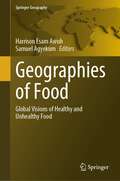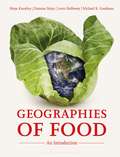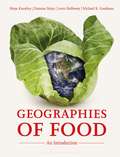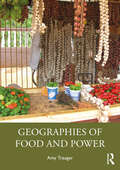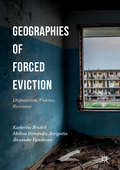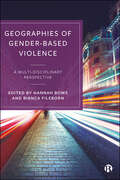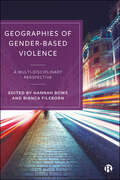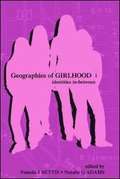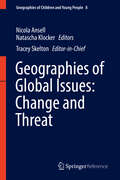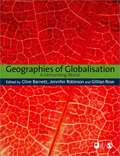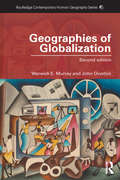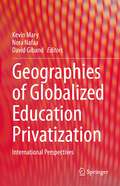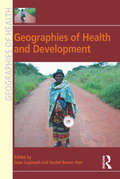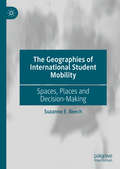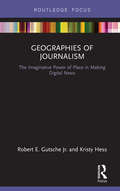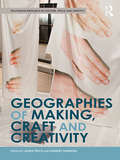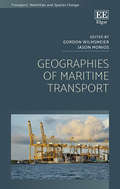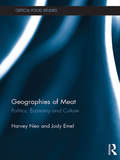- Table View
- List View
Geographies of Food: Global Visions of Healthy and Unhealthy Food (Springer Geography)
by Harrison Esam Awuh Samuel AgyekumThe book offers a multi-scale, epistemically diverse, and sense-making perspectives on the food system. The book argues that sustainable food system transformation is a complex proposition that can better thrive upon the inclusion of consumer perspectives. The book brings together scholarly works of critical scholars and practitioners who bring to bear the uniqueness of places, cultures, histories and interactions in the milieu of food.
Geographies of Food: An Introduction
by Moya Kneafsey Damian Maye Lewis Holloway Michael K. GoodmanWhat is the future of food in light of growing threats from the climate emergency and natural resource depletion, as well as economic and social inequality? This textbook engages with this question, and considers the complex relationships between food, place, and space, providing students with an introduction to the contemporary and future geographies of food and the powerful role that food plays in our everyday lives. Geographies of Food explores contemporary food issues and crises in all their dimensions, as well as the many solutions currently being proposed. Drawing on global case studies from the Majority and Minority Worlds, it analyses the complex relationships operating between people and processes at a range of geographical scales, from the shopping decisions of consumers in a British or US supermarket, to food insecurity in Sub-Saharan Africa, to the high-level political negotiations at the World Trade Organization and the strategies of giant American and European agri-businesses whose activities span several continents.With over 60 color images and a range of lively pedagogical features, Geographies of Food is essential reading for undergraduates studying food and geography.
Geographies of Food: An Introduction
by Moya Kneafsey Damian Maye Lewis Holloway Michael K. GoodmanWhat is the future of food in light of growing threats from the climate emergency and natural resource depletion, as well as economic and social inequality? This textbook engages with this question, and considers the complex relationships between food, place, and space, providing students with an introduction to the contemporary and future geographies of food and the powerful role that food plays in our everyday lives. Geographies of Food explores contemporary food issues and crises in all their dimensions, as well as the many solutions currently being proposed. Drawing on global case studies from the Majority and Minority Worlds, it analyses the complex relationships operating between people and processes at a range of geographical scales, from the shopping decisions of consumers in a British or US supermarket, to food insecurity in Sub-Saharan Africa, to the high-level political negotiations at the World Trade Organization and the strategies of giant American and European agri-businesses whose activities span several continents.With over 60 color images and a range of lively pedagogical features, Geographies of Food is essential reading for undergraduates studying food and geography.
Geographies of Food and Power
by Amy TraugerThis book provides a comprehensive overview of the production and consumption of food, suitable for use in undergraduate classrooms, either at the intermediate or advanced level. It takes an intersectional approach to difference and power and approaches standard subjects in the geography of food with a fresh perspective focusing on inequality, uneven production and legacies of colonialism. The book also focuses on places and regions often overlooked in conventional narratives, such as the Americas in the domestication of plants. The topics covered in the textbook include: descriptions and analyses of food systems histories of agricultural development with a focus on the roles of different regions major commodities such as meat, grains and produce with a focus on the place of production contemporary challenges in the food system, including labor, disasters/conflict and climate change recent and emerging trends in food and agriculture such as lab-grown meat and vertical urban farms Geographies of Food and Power takes a synthetic approach by discussing food as something produced within an interconnected system, in which labor, food quality and the environment are considered together. It will be a valuable resource for students of human geography, environmental geography, economic geography, food studies and development.
Geographies of Food and Power
by Amy TraugerThis book provides a comprehensive overview of the production and consumption of food, suitable for use in undergraduate classrooms, either at the intermediate or advanced level. It takes an intersectional approach to difference and power and approaches standard subjects in the geography of food with a fresh perspective focusing on inequality, uneven production and legacies of colonialism. The book also focuses on places and regions often overlooked in conventional narratives, such as the Americas in the domestication of plants. The topics covered in the textbook include: descriptions and analyses of food systems histories of agricultural development with a focus on the roles of different regions major commodities such as meat, grains and produce with a focus on the place of production contemporary challenges in the food system, including labor, disasters/conflict and climate change recent and emerging trends in food and agriculture such as lab-grown meat and vertical urban farms Geographies of Food and Power takes a synthetic approach by discussing food as something produced within an interconnected system, in which labor, food quality and the environment are considered together. It will be a valuable resource for students of human geography, environmental geography, economic geography, food studies and development.
Geographies of Forced Eviction: Dispossession, Violence, Resistance
by Melissa Fernández Arrigoitia Katherine Brickell Alexander VasudevanThis book offers a close look at forced evictions, drawing on empirical studies and conceptual frameworks from both the Global North and South. It draws attention to arenas where multiple logics of urban dispossession, violence and insecurity are manifest, and where wider socio-economic, political and legal struggles converge. The authors highlight the need to apply emotional and affective registers of dispossession and insecurity to the socio-political and financial economies driving forced evictions across geographic scales. The chapters each consider the distinct urban logics of precarious housing or involuntary displacements that stretch across London, Barcelona, Rio de Janeiro, Shanghai and Colombo. A timely addition to existing literature on urban studies, this collection will be of great interest to policy makers and scholars of human geography, development studies, and sociology.
Geographies of Gender-Based Violence: A Multi-Disciplinary Perspective
by Hannah Bows and Bianca FilebornWhat role does physical and virtual space play in gender-based violence (GBV)? Experts from the Global North and South use wide-ranging case studies - from public harassment in India and Kenya to harassment on Twitter - to examine how spaces can facilitate or prevent GBV and showcase strategies for prevention and intervention. Students and academics from a range of disciplines will discover how existing research connects with practice and policy developments, the current gaps in research and a future agenda for GBV studies.
Geographies of Gender-Based Violence: A Multi-Disciplinary Perspective
What role does physical and virtual space play in gender-based violence (GBV)? Experts from the Global North and South use wide-ranging case studies - from public harassment in India and Kenya to harassment on Twitter - to examine how spaces can facilitate or prevent GBV and showcase strategies for prevention and intervention. Students and academics from a range of disciplines will discover how existing research connects with practice and policy developments, the current gaps in research and a future agenda for GBV studies.
Geographies of Gendered Punishment: Women’s Imprisonment in Global Context (Palgrave Studies in Prisons and Penology)
by Anastasia Chamberlen Mahuya BandyopadhyayThis edited book explores new and enduring themes in the gendered experience of incarceration across the world. Capturing global debates and research on women’s treatment, their coping and resistances in penal settings, the collection promotes a feminist agenda that is attuned to the inherently patriarchal and intersectionally oppressive structures of contemporary punishment. It seeks to map policies and campaigns around women’s criminalisation across the world and offers one of the most comprehensive overviews of women’s imprisonment experiences across the Global North and Global South. Each chapter focusses on a different geographic context and theme and aims to provide the intellectual groundwork for a critical, world-wide movement advocating for women’s decarceration. As a whole, the collection offers a robust empirical understanding of women’s punishment in non-western, Global South contexts and also revisits ongoing debates in feminist accounts of punishment in the Global North. In doing so, the collection examines hierarchical geopolitical relations between privileged and underprivileged nations, reflecting global inequalities and structural violence rooted in legacies of imperialism and colonialism. Overall, the edited collection shows how centering women’s peripheralized experiences can radically reshape our understanding of punishment and offers a new intellectual, methodological, and political means through which to think about gendered identity and imprisonment in the 21st Century.
Geographies of Girlhood: Identities In-Between
by Pamela J. Bettis Natalie G. AdamsGeographies of Girlhood: Identities In-Between explores how adolescent girls come to understand themselves as female in this culture, particularly during a time when they are learning what it means to be a woman and their identities are in-between that of child and adult, girl and woman. It illuminates the everyday realities of adolescent girls and the real issues that concern them, rather than what adult researchers think is important to adolescent girls. The contributing authors take seriously what girls have to say about themselves and the places and discursive spaces that they inhabit daily. Rather than focusing on girls in the classroom, the book explores adolescent female identity in a myriad of kid-defined spaces both in-between the formal design of schooling, as well as outside its purview--from bedrooms to school hallways to the Internet to discourses of cheerleading, race, sexuality, and ablebodiness. These are the geographies of girlhood, the important sites of identity construction for girls and young women. This book is situated within the fledgling field of Girls Studies. All chapters are based on field research with adolescent girls and young women; hence, the voices of girls themselves are primary in every chapter. All of the authors in the text use the notion of liminality to theorize the in-between spaces and places of schools that are central to how adolescent girls construct a sense of self. The focus of the book on the fluidity of femininity highlights the importance of race, class, sexual orientation, and other salient features of personal identity in discussions of how girls construct gendered identities in different ways. Geographies of Girlhood: Identities In-Between challenges scholars, professionals, and students concerned with gender issues to take seriously the everyday concerns of adolescent girls. It is recommended as a text for education, sociology, and women's studies courses that address these issues.
Geographies of Girlhood: Identities In-Between (PDF)
by Pamela J. Bettis Natalie G. AdamsGeographies of Girlhood: Identities In-Between explores how adolescent girls come to understand themselves as female in this culture, particularly during a time when they are learning what it means to be a woman and their identities are in-between that of child and adult, girl and woman. It illuminates the everyday realities of adolescent girls and the real issues that concern them, rather than what adult researchers think is important to adolescent girls. The contributing authors take seriously what girls have to say about themselves and the places and discursive spaces that they inhabit daily. Rather than focusing on girls in the classroom, the book explores adolescent female identity in a myriad of kid-defined spaces both in-between the formal design of schooling, as well as outside its purview--from bedrooms to school hallways to the Internet to discourses of cheerleading, race, sexuality, and ablebodiness. These are the geographies of girlhood, the important sites of identity construction for girls and young women. This book is situated within the fledgling field of Girls Studies. All chapters are based on field research with adolescent girls and young women; hence, the voices of girls themselves are primary in every chapter. All of the authors in the text use the notion of liminality to theorize the in-between spaces and places of schools that are central to how adolescent girls construct a sense of self. The focus of the book on the fluidity of femininity highlights the importance of race, class, sexual orientation, and other salient features of personal identity in discussions of how girls construct gendered identities in different ways. Geographies of Girlhood: Identities In-Between challenges scholars, professionals, and students concerned with gender issues to take seriously the everyday concerns of adolescent girls. It is recommended as a text for education, sociology, and women's studies courses that address these issues.
Geographies of Global Issues: Change and Threat
by Nicola Ansell, Natascha Klocker and Tracey SkeltonGeographies Of Globalisation: A Demanding World (PDF)
by Clive Barnett Gillian Rose Jennifer RobinsonGeographies of Globalization explores the geographies of proximity and distance that shape globalization, and considers the politics of responsibility that it brings. It examines globalization in terms of: o economy - patterns of trade, work and finance o politics - political institutions and the role of political campaigns o technology - how technologies are networking the world o migration - the dynamics of mobility. Including key readings, summary boxes, activities, and illustrative case-study material throughout, the book explains how the geographies of globalization - the ways in which things are brought closer together or kept apart - are critical to our understanding of how globalization works now, and how we respond to it.
Geographies of Globalization (Routledge Contemporary Human Geography Series)
by Warwick E. Murray John OvertonGeographies of Globalization 2nd edition offers an animated and fully-updated exposition of the geographical impacts of globalization and the contribution of human geography to studies and debates in this area. Energetic and engaging, this book: • Illustrates how the core principles of human geography – such as space and scale – lead to a better understanding of the phenomenon • Debates the historical evolution of globalized society • Analyses the interconnected economic, political and cultural geographies of globalization • Examines the impact of global transformations ‘on the ground’ using examples from six continents • Discusses the three global crises currently facing the world – inequality, the environment and unstable capitalism most recently manifested in the Great Recession • Articulates a human geographical framework for progressive globalization and approaching solutions to the problems we face Boxed sections highlight key concepts and innovative work by geographers as well as topical and lively debates concerning current global trends. The book is also generously illustrated with a wide range of Figures, photographs, and maps.
Geographies of Globalization (Routledge Contemporary Human Geography Series)
by Warwick E. Murray John OvertonGeographies of Globalization 2nd edition offers an animated and fully-updated exposition of the geographical impacts of globalization and the contribution of human geography to studies and debates in this area. Energetic and engaging, this book: • Illustrates how the core principles of human geography – such as space and scale – lead to a better understanding of the phenomenon • Debates the historical evolution of globalized society • Analyses the interconnected economic, political and cultural geographies of globalization • Examines the impact of global transformations ‘on the ground’ using examples from six continents • Discusses the three global crises currently facing the world – inequality, the environment and unstable capitalism most recently manifested in the Great Recession • Articulates a human geographical framework for progressive globalization and approaching solutions to the problems we face Boxed sections highlight key concepts and innovative work by geographers as well as topical and lively debates concerning current global trends. The book is also generously illustrated with a wide range of Figures, photographs, and maps.
Geographies of Globalized Education Privatization: International Perspectives
by Kevin Mary Nora Nafaa David GibandThis book explores the complex and various forms that privatization of education takes on a global scale at different ages of schooling. Through the spread of neoliberal policies in education both in the global North and the global South, the book suggests that this process is leading to new forms of schooling and socio-spatial dynamics linked to the creation of increasingly competitive school markets. The book highlights some of the main issues that such competition generates by focusing on the acceleration of the segregative processes on one hand but also on the alternatives that are emerging regarding this global context on the other hand. It considers processes of domination, hegemony, but also exclusion and segregation, eventually exploring contradictions inherent to societies. It presents innovative empirical and conceptual research by international scholars from the fields of social geography, sociology, history and demography in the United States, Lebanon, France, Afghanistan and Chile, thereby transcending disciplinary boundaries. Developed in under or unexplored contexts, the book broadens the reflection to social representations, individual and collective strategies, adaptation, innovation and also resistances.
Geographies of Health and Development (Geographies of Health Series)
by Rachel Bezner Kerr Isaac LuginaahThe geographies of health and development is an emerging sub-discipline, tying in with many of the conceptual, theoretical and practical components of other disciplines working in health, health care, economics, and international development. Spatially and theoretically grounded in geography, this collection offers a fresh perspective on the dialectic relationships between health and development. Health problems in a developing context take on much higher rates of prevalence as a result of the varied cultural, structural and economic vulnerabilities of the people they impact. This book begins by exploring some of the circumstances surrounding the distinctive health inequities currently facing many developing countries, including malaria, maternal mortality and HIV/AIDS. This is followed by a discussion of how matters of physical access and human resource issues and, perhaps most importantly, the challenges of financing, together shape the access and utilization of health care. Examining how the environment interacts to influence the health of the people that live there, the next section includes discussion around challenges of food (in)security, and the importance of clean and uncontaminated water for health. Finally, the book explores the influence of globalization on health, specifically within the urban environment, against the backdrop of global health policy.
Geographies of Health and Development (Geographies of Health Series)
by Isaac Luginaah Rachel Bezner KerrThe geographies of health and development is an emerging sub-discipline, tying in with many of the conceptual, theoretical and practical components of other disciplines working in health, health care, economics, and international development. Spatially and theoretically grounded in geography, this collection offers a fresh perspective on the dialectic relationships between health and development. Health problems in a developing context take on much higher rates of prevalence as a result of the varied cultural, structural and economic vulnerabilities of the people they impact. This book begins by exploring some of the circumstances surrounding the distinctive health inequities currently facing many developing countries, including malaria, maternal mortality and HIV/AIDS. This is followed by a discussion of how matters of physical access and human resource issues and, perhaps most importantly, the challenges of financing, together shape the access and utilization of health care. Examining how the environment interacts to influence the health of the people that live there, the next section includes discussion around challenges of food (in)security, and the importance of clean and uncontaminated water for health. Finally, the book explores the influence of globalization on health, specifically within the urban environment, against the backdrop of global health policy.
The Geographies of International Student Mobility: Spaces, Places and Decision-Making
by Suzanne E. BeechThis book offers critical insights into the geographies of the international student higher education experience from initial recruitment, through to the plethora of personal factors which influence their decisions to become mobile and experiences when abroad. From the student perspective these include, but are not limited to, the importance of social networks, desire for a multicultural experience and the attraction to certain locations as discussed in this volume. However, unlike other work, it also reflects on the motivations of the HEIs themselves and their need to continue recruiting students in the face of greater competition from overseas. Recognising this omission, this book also analyses the resulting migration industries and how these are sustained (and even necessitated) by the sector. It is, therefore, the first to bring together these wider institutional narratives with those of the students resulting in a holistic and comprehensive insight into the student mobility process.
Geographies of Journalism: The Imaginative Power of Place in Making Digital News (Disruptions)
by Robert E. Gutsche Jr. Kristy HessGeographies of Journalism connects theoretical and practical discussions of the role of geotechnologies, social media, and boots-on-the-ground journalism in a digital age to underline the complications and challenges that place-making in the press brings to institutions and ideologies. By introducing and applying approaches to geography, cultural resistance, and power as it relates to discussions of space and place, this book takes a critical look at how online news media shapes perceptions of locales. Through verisimilitude, storytelling methods, and journalistic evidence shaped by sources and news processes, the press play a critical role in how audiences shape interpretations of social conditions "here" and "there", and place responsibility for socio-political issues that appear in everyday life. Issues of proximity, place, territory, news myth, placemaking, and power align in this book of innovative and new assessments of journalism in the digital age. This is a valuable resource for scholars across the fields of human geography, journalism, and mass media.
Geographies of Making, Craft and Creativity (Routledge Research in Culture, Space and Identity)
by Laura Price Harriet HawkinsThis book brings together cutting-edge research from leading international scholars to explore the geographies of making and craft. It traces the geographies of making practices from the body, to the workshop and studio, to the wider socio-cultural, economic, political, institutional and historical contexts. In doing so it considers how these geographies of making are in and of themselves part of the making of geographies. As such, contributions examine how making bodies and their intersections with matter come to shape subjects, create communities, evolve knowledge and make worlds. This book offers a forum to consider future directions for the field of geographies of making, craft and creativity. It will be of great interest to creative and cultural geographers, as well as those studying the arts, culture and sociology.
Geographies of Making, Craft and Creativity (Routledge Research in Culture, Space and Identity)
by Laura Price Harriet HawkinsThis book brings together cutting-edge research from leading international scholars to explore the geographies of making and craft. It traces the geographies of making practices from the body, to the workshop and studio, to the wider socio-cultural, economic, political, institutional and historical contexts. In doing so it considers how these geographies of making are in and of themselves part of the making of geographies. As such, contributions examine how making bodies and their intersections with matter come to shape subjects, create communities, evolve knowledge and make worlds. This book offers a forum to consider future directions for the field of geographies of making, craft and creativity. It will be of great interest to creative and cultural geographers, as well as those studying the arts, culture and sociology.
Geographies of Maritime Transport (Transport, Mobilities and Spatial Change)
by Gordon Wilmsmeier Jason MoniosMaritime transport is a constantly evolving critical transport mode, thoroughly explored in this timely book from a geographical perspective. Chapters cover maritime shipping markets, territories of maritime shipping, institutional dimensions, and environmental and future challenges. With contributions from researchers in a range of disciplines, including geography, economics, law and spatial planning, as well as practitioners, the book emphasizes the wide-ranging interest in and impacts of maritime transport. Offering empirically rich studies of historical and contemporary geographies of maritime transport, this book also looks ahead to the importance of adaptation and of questioning the effects of the continued economization of maritime transport. Geography, transport economics, logistics and management scholars will appreciate the thorough case studies and in-depth analyses of the topics offered in the book. It will also benefit industry and government representatives looking for a broader understanding of the recent evolution of maritime transport in a globalizing world.
Geographies of Meat: Politics, Economy and Culture (Critical Food Studies)
by Harvey Neo Jody EmelWith the ever rising demand for meat around the world, the production of meat has changed dramatically in the past few decades. What has brought about the increasing popularity and attendant normalization of factory farms across many parts of the world? What are some of the ways to resist such broad convergences in meat production and how successful are they? This book locates the answers to these questions at the intersection between the culture, science and political economy of meat production and consumption. It details how and why techniques of production have spread across the world, albeit in a spatially uneven way. It argues that the modern meat production and consumption sphere is the outcome of a complex matrix of cultural politics, economics and technological faith. Drawing from examples across the world (including America, Europe and Asia), the tensions and repercussions of meat production and consumption are also analyzed. From a geographical perspective, food animals have been given considerably less attention compared to wild animals or pets. This book, framed conceptually by critical animal studies, governmentality and commodification, is a theoretically driven and empirically rich study that advances the study of food animals in geography as well as in the wider social sciences.
Geographies of Meat: Politics, Economy and Culture (Critical Food Studies)
by Harvey Neo Jody EmelWith the ever rising demand for meat around the world, the production of meat has changed dramatically in the past few decades. What has brought about the increasing popularity and attendant normalization of factory farms across many parts of the world? What are some of the ways to resist such broad convergences in meat production and how successful are they? This book locates the answers to these questions at the intersection between the culture, science and political economy of meat production and consumption. It details how and why techniques of production have spread across the world, albeit in a spatially uneven way. It argues that the modern meat production and consumption sphere is the outcome of a complex matrix of cultural politics, economics and technological faith. Drawing from examples across the world (including America, Europe and Asia), the tensions and repercussions of meat production and consumption are also analyzed. From a geographical perspective, food animals have been given considerably less attention compared to wild animals or pets. This book, framed conceptually by critical animal studies, governmentality and commodification, is a theoretically driven and empirically rich study that advances the study of food animals in geography as well as in the wider social sciences.
